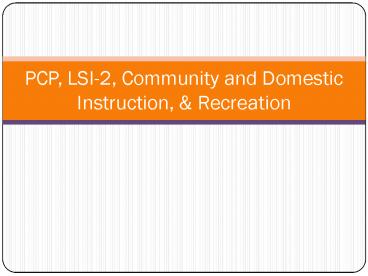PCP, LSI2, Community and Domestic Instruction, - PowerPoint PPT Presentation
1 / 18
Title:
PCP, LSI2, Community and Domestic Instruction,
Description:
3. Write your complete lesson plan no latter than Saturday or Sunday by 4:00 PM ... small group Define Domestic outcomes (tasks peopled do) for different age groups: ... – PowerPoint PPT presentation
Number of Views:43
Avg rating:3.0/5.0
Title: PCP, LSI2, Community and Domestic Instruction,
1
PCP, LSI-2, Community and Domestic Instruction,
Recreation
2
Agenda
- Review Checklist and Template for LSI-2
- Success in LSI-2
- Community Instruction
- Domestic Instruction
- Domestic Activity
- Community and Domestic Instruction Activity
3
LSI-2 Success
- 1. Pay attention to notes and book
- 2. Further your writing with knowledge from the
book - 3. Write your complete lesson plan no latter than
Saturday or Sunday by 400 PM - 4. Review it Monday morning before class. And ask
a few final questions. - 5. Post questions with your next reading summary.
- 6. Dont rely on your evaluation checklist rely
on your learning - 7. Incorporate relevant feedback from LSI-1
4
Learning Objectives
- 1. Know points for LSI-2 and How to succeed
- 2. Know instructional considerations for domestic
and community skills - 3. Know instructional considerations for
recreation and leisure skills.
5
What are Community Skills?
- Work in groups- see if you can come up with some
skills based on your reading for today. - Are they important to teach students with mild to
moderate disability?
6
Instruction in the Community
- Frequency increases the older the student gets
- Can take place combined with vocational learning
activities - Frequency is depend on student need
- For students with MM disabilities, may not need
frequent visits
7
Style of Instruction in Community
- Naturalistic
- For students with MS disability systematic
instruction is essential - Data collection is requisite
- Small groups
8
Preparing for Community Participation
- Think about the community facilities and
resources that you have used as you grew from
childhood to adulthood? - How did you participate as a young child?
- How did you participate as an adolescent?
- How do you participate as an adult?
9
Community Preparation
- Know where you are going well
- Make sure all permission is granted
- Prepare students prior to leaving
- Be organized, and make sure students know safety
and emergency procedures and you have taught
them. - Have contingency plans Transportation, crisis,
etc. - Take backpack with all needed information and
instructional supports - Go in small numbers
- Make sure an administrator knows where you are at
and what you are doing - Bring Communication (Cell phone)
- Bring money
- Use Parents, assistants, and volunteers, peers,
older students
10
Examples of transition activities related to
community participation and leisure
- Community experiences
- Development of adult living objectives
- Connection to adult services
- Instruction and related services
11
Guidelines for effective simulation(Nietupski
Hamre-Nietupski, 1986)
- Inventory community settings to determine range
of stimulus and response variations facing
learners - Systematically vary simulations to provide a
sufficient range of instructional exemplars - Use community performance data to modify
simulation (See Nietupski, J., Hamre-Nietupski,
S., Clancy, P., Veerhusen, K. (1986) and
Branham, R.S., Collins, B.C., Schuster, J.W.,
Kleinert, H. (1999). For reference
12
Domestic Activities
- In small group Define Domestic outcomes (tasks
peopled do) for different age groups - Group A Pre-school and Early Elementary
- Group B Grades 3-5
- Group C Grades 6-8
- Group D Grades 9-12
- All groups- connect your outcome/activity to
adult outcome you hope the student is able to do
that will make them independent. Use your text
and Syracuse for ideas. - Finally, pick one and expand the skills needed to
achieve it (Like figure 17-8)
13
Teaching Domestic Skills
- Use Visual Supports
- Assistive technology
- Systematic Instruction
- Incorporate Families as much as possible
- Practice in multiple settings
14
Quick Steps Lesson Plan
- 2 groups develop a community learning activity
based for a student in high school - 2 groups do a learning domestic activity for a
student in high school - Write an Behavioral Objective
- Describe the student Try to use a student from
someone's practicum site or that they may be
familiar with - Explain a prompting strategey
15
How can we define leisure?
- An individuals perception of freedom to choose
to participate in meaningful, enjoyable, or
satisfying experiences. - Dattilo (1991)
16
Leisure and Recreation as a Transition Outcome
- What leisure outcomes would you consider as
successful outcomes for adults?
17
Explanations for Unoccupied Free Time for
Individuals with Disabilities
- Lack of skills to participate in recreational
activities - Lack of skills in decision making or identifying
preferences and choices in planning their free
time - Lack of information regarding resources and
opportunities - Lack of friends
- Family or caretaker imposed restrictions
18
Families and Recreation
- What role does family play in a recreational
assessment? - Pick a student who you feel needs recreation
instruction. - Think of some specific questions you would ask
the family - Then pick an activity you want to instruct the
student in. - Develop an instructional activity based on what
we have learned and the chapter you read.































